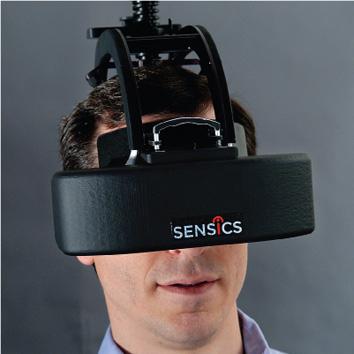Virtual reality feels cutting-edge. It’s been around in some form since the ’90s (and even before, sort of), but the technology has really started to come into its own in the past few years. There are VR films at Sundance, VR news apps, and, of course, VR video games. So for VR company Sensics, patience has been crucial.
“Virtual reality trade shows used to be half a dozen exhibitors. It was like a club,” says CEO Yuval Boger. Founded in the late ’90s, Sensics is based on technology developed at Johns Hopkins for Honda. When developing a new model, the car company wanted to sit in it and get a feel for its design long before investing in physical prototypes. This led to a 6-million-pixel-per-eye head-mounted display. (Currently, the optimal Oculus Rift resolution is 2,160-by-1,200, or 2.6 million pixels per eye, but computers powering the Rift process about 233 million pixels per second.)
In the early 2000s Sensics didn’t have access to cheap components and processing power like it does now, but for a cost it could deliver much of what consumers are experiencing today. Most clients were big corporations, research organizations, or defense agencies. “I remember standing in front of a mirror practicing saying, ‘These goggles cost $200,000’ without bursting into laughter,” Boger says.
For the past year, Sensics has been working with gaming company Razer on an industry standard for VR called Open-Source Virtual Reality. For $300 (compared to Oculus’ $600), consumers can buy an OSVR Hacker Dev Kit—a headset that connects to “a mid-tier gaming PC and upwards” to deliver VR experiences. OSVR is often compared with Android because it is an open-source standard accepted by 300 partners and growing. The idea is to enable manufacturers to provide VR equipment at a variety of price points and qualities while allowing Internet-connected peripherals, like smart clothing or biometric trackers, to integrate into the VR experience.
“There are going to be more and more sensors connected to the VR experience in 2016,” Boger says. “As a result, people are going to run into, ‘Oh my god, there are no standards for how devices are going to talk to each other.’ But we can say that we are the de-facto standard. Today we support hundreds of devices.”
For example, last year Oculus announced that it would stop supporting Mac development. So when Mozilla WebVR (browser-powered virtual reality) approached OSVR about a partnership, it asked about potential Mac compatibility. OSVR couldn’t offer it on the spot but said it would put the challenge out to its open-source community. Within three weeks, developers around the world had volunteered their time to add the functionality Mozilla wanted.
Consumer virtual reality has certainly come a long way since products like Nintendo’s Virtual Boy debuted in 1995. But the technology behind what we see today isn’t just the result of a sudden boom—it’s been evolving steadily for the past two decades. Boger is enjoying it. “One of the fun things about Sensics is that for 10 years people have come in and said, ‘Here’s what I want to do with VR.’ And now with a $300 device it’s becoming accessible.”
